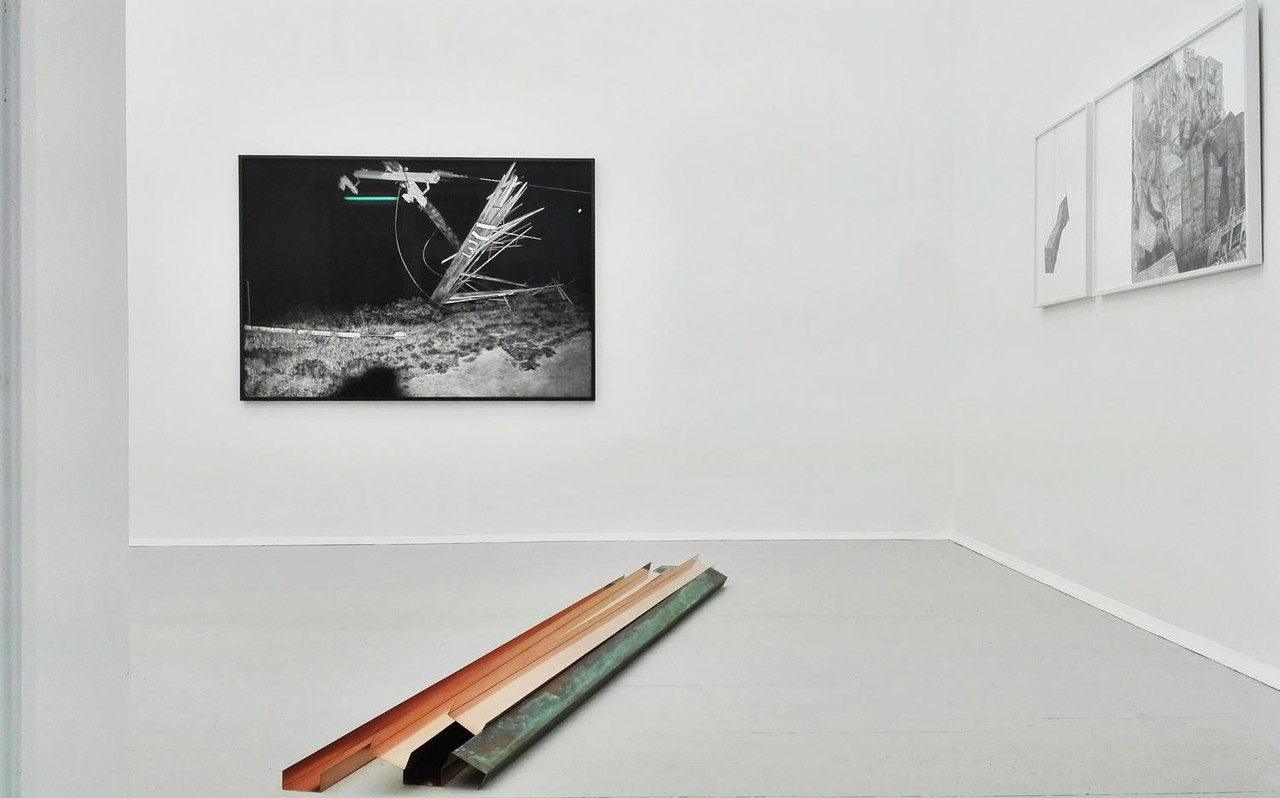Natalia Stachon
Metal Time
10 Mar - 29 Apr 2017
NATALIA STACHON
Metal Time
10 March – 29 April 2017
De(con)struction and transformation in their processes and forms characterise the works of Natalia Stachon (*1976, Katowice, Poland). To this end the artist, who lives in Berlin, references, abstracts and usurps diverse pictures, finished pieces, and literature, preferably lyrics. William Burroughs (1914-1997) serves as a strong point of reference, amongst others his novel 'Nova Express' of 1964, from which the exhibition title is borrowed:
But I am not one in space I am one in time—Metal time—Radioactive time—So of course I tried to keep you all out of space—That is the end of time—[1]
Methodologically, Natalia Stachon aligns herself with Burroughs' cut-ups and fold-ins: differing textual sources are cut up into small fragments, or folded up and rearranged, or interleaved. With this actually simple method of composition which is based on deconstruction and chance as well as abstraction and openness of form, Burroughs is able to educe an impressive language. From the same working process Stachon develops a universal legibility that generates its meaning out of overlappings. For her works THIS DEAD WHISTLE STOP and NEVER WAS MINE, she uses neon signs, serving for orientation, and transforms them, in that quotations from Burroughs' cut-up poems from the 1960s are hung up over each other on rubberised aluminium plaques. Their function is removed from the signs; due to the overlappings, they can only be read and deciphered in piecemeal fashion.
Stachon exploits another sort of deconstruction in her sculptures, which come close to Minimalism: Blinding 02 is comprised of nine standardised U-profiles of copper, of which two have developed a patina. During its elaborate genesis, the material is altered almost identically by being touched, through oxidation and humidity, continually until it becomes dull and matte. The choice of material is a conscious reference to the works of Robert Morris and Carl Andre, while the apparently arbitrary placement in the space, however, translates the reference to Minimalism into an emptied quotation
Pictures in which destroyed or snapped electricity poles can be seen serve as a model for her series of drawings 'The History of Aberrations': partially lit by spotlights, they float like strange, threatening sculptures over the road, in a landscape completely engulfed by darkness. They are an anomaly in the endless system of poles standing in front of and behind them. They tell a history of deviation. And they are motifs which speak impressively about the absurdity of our daily life.
[1] William S. Burroughs, Nova Express, London, 2014, p. 80
Metal Time
10 March – 29 April 2017
De(con)struction and transformation in their processes and forms characterise the works of Natalia Stachon (*1976, Katowice, Poland). To this end the artist, who lives in Berlin, references, abstracts and usurps diverse pictures, finished pieces, and literature, preferably lyrics. William Burroughs (1914-1997) serves as a strong point of reference, amongst others his novel 'Nova Express' of 1964, from which the exhibition title is borrowed:
But I am not one in space I am one in time—Metal time—Radioactive time—So of course I tried to keep you all out of space—That is the end of time—[1]
Methodologically, Natalia Stachon aligns herself with Burroughs' cut-ups and fold-ins: differing textual sources are cut up into small fragments, or folded up and rearranged, or interleaved. With this actually simple method of composition which is based on deconstruction and chance as well as abstraction and openness of form, Burroughs is able to educe an impressive language. From the same working process Stachon develops a universal legibility that generates its meaning out of overlappings. For her works THIS DEAD WHISTLE STOP and NEVER WAS MINE, she uses neon signs, serving for orientation, and transforms them, in that quotations from Burroughs' cut-up poems from the 1960s are hung up over each other on rubberised aluminium plaques. Their function is removed from the signs; due to the overlappings, they can only be read and deciphered in piecemeal fashion.
Stachon exploits another sort of deconstruction in her sculptures, which come close to Minimalism: Blinding 02 is comprised of nine standardised U-profiles of copper, of which two have developed a patina. During its elaborate genesis, the material is altered almost identically by being touched, through oxidation and humidity, continually until it becomes dull and matte. The choice of material is a conscious reference to the works of Robert Morris and Carl Andre, while the apparently arbitrary placement in the space, however, translates the reference to Minimalism into an emptied quotation
Pictures in which destroyed or snapped electricity poles can be seen serve as a model for her series of drawings 'The History of Aberrations': partially lit by spotlights, they float like strange, threatening sculptures over the road, in a landscape completely engulfed by darkness. They are an anomaly in the endless system of poles standing in front of and behind them. They tell a history of deviation. And they are motifs which speak impressively about the absurdity of our daily life.
[1] William S. Burroughs, Nova Express, London, 2014, p. 80

